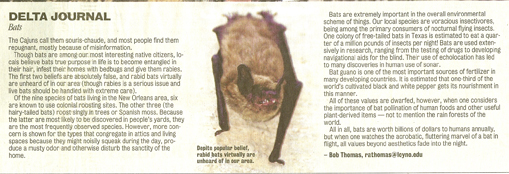The Cajuns call them souris-chaude and most people find them repugnant, more due to misinformation than truth.
Though bats are among our most interesting native citizens, locals believe bats true purpose in life is to become entangled in their hair, infest their homes with bedbugs, and give them rabies. The first two beliefs are absolutely false, and rabid bats are virtually unheard of in our area (though rabies is a serious issue and live bats should be handled with extreme care).
Of the nine species of bats living in the New Orleans area, six are known to use colonial roosting sites. The other three (the hairy-tailed bats) roost singly in trees or Spanish moss. Because the latter are most likely to be discovered in people’s yards, they are the most frequently observed species. However, more concern is shown for the types that congregate in attics and living spaces because they may noisily squeak during the day, produce a musty odor, and otherwise disturb the sanctity of the home.
Bats are extremely important in the overall environmental scheme of things. Our local species are voracious insectivores, being among the primary consumers of nocturnal flying insects. One colony of free-tailed bats in Texas is estimated to eat a quarter of a million pounds of insects per night! Bats are used extensively in research, ranging from the testing of drugs to developing navigational aids for the blind. Their use of echolocation has led to many discoveries in human use of sonar.
Bat guano is one of the most important sources of fertilizer in many developing countries. It is estimated that one third of the world’s cultivated black and white pepper gets its nourishment in this manner.
All of these values are dwarfed, however, when one considers the importance of bat pollination of human foods and other useful plant-derived items – not to mention the rainforests of the world.
All in all, bats are worth billions of dollars to humans annually, but when one watches the acrobatic, fluttering marvel of a bat in flight, all values beyond aesthetics fade into the night.
Bats of New Orleans
- Corynorhinus (=Plecotus) rafinesquii, Rafinespue’s Big-earred Bat
- Eptesicus fuscus, Big Brown Bat
- Lasiurus borealis, Red Bat
- Lasiurus cinereus, Hoary Bat
- Lasiurus intermedius, Northern Yellow bat
- Lasiurus seminolus, Seminole Bat
- Myotis austroriparius, Southeastern Myotis
- Nycticeius humeralis, Evening Bat
- Pipistrellus subflavus, Eastern Pepistrelle
- Tadarida brasiliensis, Brazilian Free-tailed Bat
Also published in Delta Journal, The Times Picayune, April 5, 1989.
